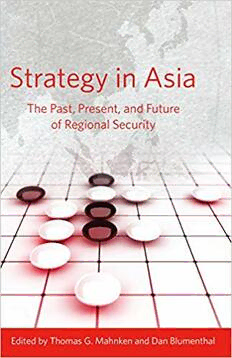
Strategy in Asia: The Past, Present, and Future of Regional Security PDF
Preview Strategy in Asia: The Past, Present, and Future of Regional Security
Strategy in Asia Strategy in Asia The PasT, PresenT, and FuTure oF regional securiTy Edited by Thomas G. Mahnken and Dan Blumenthal Stanford Security Studies An Imprint of Stanford University Press Stanford, California Stanford University Press Stanford, California ©2014 by the Board of Trustees of the Leland Stanford Junior University. All rights reserved. No part of this book may be reproduced or transmitted in any form or by any means, electronic or mechanical, including photocopying and recording, or in any information storage or retrieval system without the prior written permission of Stanford University Press. Printed in the United States of America on acid-free, archival-quality paper Library of Congress Cataloging-in-Publication Data Strategy in Asia : the past, present, and future of regional security / edited by Thomas G. Mahnken and Dan Blumenthal. pages cm Includes bibliographical references and index. isbn 978-0-8047-9149-6 (cloth : alk. paper) — isbn 978-0-8047-9274-5 (pbk. : alk. paper) 1. Asia—Strategic aspects. 2. National security—Asia. 3. Security, International— Asia. 4. Strategic culture—Asia. 5. Asia—Military policy. I. Mahnken, Thomas G., editor of compilation. II. Blumenthal, Dan, editor of compilation. ua830.S84 2014 355′.03355—dc23 2014010113 isbn 978-0-8047-9282-0 (electronic) Typeset by Newgen in 10/14 Minion conTenTs List of Maps vii Preface ix Acknowledgments xiii Acronyms xv Introduction: Thinking About Strategy in Asia Aaron L. Friedberg 1 1 Asia as a Warfighting Environment Roy Kamphausen 11 2 The Cyclical Nature of Chinese Sea Power Bruce Elleman 26 3 Chinese Maritime Geography Toshi Yoshihara 43 4 Mahan and the South China Sea James R. Holmes 61 5 The US Alliance Structure in Asia Michael R. Auslin 73 6 Strategy and Culture Colin S. Gray 92 7 The Chinese Way of War Andrew R. Wilson 108 v vi conTenTs 8 The Japanese Way of War S. C. M. Paine 130 9 The Indian Way of War Timothy D. Hoyt 147 10 Military Modernization in Asia Richard A. Bitzinger 162 11 The Economic Context of Strategic Competition Bradford A. Lee 185 12 Nuclear Deterrence in Northeast Asia Michael S. Chase 205 13 Arms Races and Long-Term Competition Thomas G. Mahnken 225 14 Irregular Warfare in Asia Michael Evans 241 Conclusion: Toward a Research Agenda Thomas G. Mahnken, Dan Blumenthal, and Michael Mazza 265 About the Contributors 275 Index 279 MaPs 1.1 Greater Asia 13 2.1 China in 1927 34 3.1 First and Second Island Chains 46 4.1 South China Sea 68 5.1 Senkaku Islands 79 7.1 Malacca Strait 117 vii PreFace this volume grew out of the recognition of two important facts. The first involves the increasing strategic weight of the Asia-Pacific region, a trend that warrants greater attention from scholars and policy makers alike. The second is focused on the growing importance of the strategic realties of Asia, which require viewing the entire continent under the multiple lenses of geography, culture, history, politics, and economics. Many of the concepts introduced by the advent of the field of strategic studies, including deterrence and arms race, are similarly quite fruitful. An understanding of strategic studies can heighten our comprehension of Asia much as a deeper understanding of the region can enhance our knowl- edge of strategy. Fundamentally, the field of strategic studies is concerned with the relationship between politics and military force. On a basic level, however, strategy is universal: it can be applied in any state or at any time because hu- man nature remains essentially unchanged. Yet strategy is also contextual: strategy is formulated and implemented in specific geographic, cultural, and social environments. As an academic enterprise, the field of strategic studies arose in the wake of World War II and during the Cold War. The geopolitics of that period directly and indirectly influenced thinking on deterrence, arms races, and military balances. Although students of strategic studies consult Asian classics by Sun Tzu, among others, the field largely springs from Western thinkers, includ- ing Thucydides, Tacitus, Clausewitz, Jomini, Mahan, Corbett, Schelling, and Brodie. This volume looks at whether, and to what extent, strategic studies remain valid for Asia of the twenty-first century. ix
